
Eric Cheney was an English motorcycle racer, designer and independent constructor. He was known as one of the best motorcycle frame designers of his era, concentrating mainly in the off-road competition aftermarket.

The Norton Motorcycle Company is a brand of motorcycles headquartered in Solihull, West Midlands,, England. For some years around 1990, the rights to use the name on motorcycles was owned by North American financiers.
Triumph Engineering Co Ltd was a British motorcycle manufacturing company, based originally in Coventry and then in Meriden. A new company, Triumph Motorcycles Ltd, based in Hinckley, gained the name rights after the end of the company in the 1980s and is now one of the world's major motorcycle manufacturers.
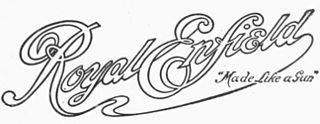
Royal Enfield was a brand name under which The Enfield Cycle Company Limited of Redditch, Worcestershire, England, sold motorcycles, bicycles, lawnmowers and stationary engines which it manufactured. Enfield Cycle Company also used the brand name "Enfield" without the "Royal".
Penton was a rebadged American brand of off-road enduro motorcycles designed by John Penton and manufactured by KTM in Austria for distribution in the United States between 1968 and 1978.

The Triumph Trident and BSA Rocket 3 was a technically advanced, high-performance roadster motorcycle made by Triumph Engineering and BSA from 1968 to 1975, and sold under both the Triumph and BSA marques. Alongside the Honda CB750, and later the Kawasaki triples, it brought a new level of sophistication to street motorcycles, marking the beginning of the superbike era. The Honda CB750 overshadowed the Trident to be remembered as the 'first superbike', in spite of the Triumph Trident actually debuting before the Honda by a few weeks.

The Triumph Bonneville is a standard motorcycle featuring a parallel-twin four-stroke engine and manufactured in three generations over three separate production runs.

Triton motorcycles were hybrid motor cycles built from the 1950s to the 1970s that involved fitting Triumph engines into Norton frames. Because no factory offered Triton motorcycles, they were typically privately constructed. However, some UK dealers offered complete bikes. The aim was to combine the best elements of each marque and thus gain a bike superior to either. The name 'Triton' is a contraction of Triumph and Norton; 'Triton' was the name of a mythological Greek God.

Geoff Monty was an English professional motorcycle racer, constructor, rider-sponsor and retail dealer, initially based in Kingston on Thames and later – under the name Monty and Ward – Twickenham areas, near London, with a move to Edenbridge, Kent by 1968.

Associated Motor Cycles (AMC) was a British motorcycle manufacturer founded by the Collier brothers as a parent company for the Matchless and AJS motorcycle companies. It later absorbed Francis-Barnett, James, and Norton before incorporation into Norton-Villiers. Henry Herbert Collier founded Matchless as a cycle company in 1878. His sons Henry (Harry) and Charles (Charlie) joined him and the name was changed to H. Collier & Sons.

The BSA Gold Star is a motorcycle made by BSA from 1938 to 1963. They were 350 cc and 500 cc single-cylinder four-stroke production motorcycles known for being among the fastest bikes of the 1950s. Being hand built and with many optional performance modifications available, each motorcycle came from the factory with documented dynamometer test results, allowing the new owner to see the horsepower (bhp) produced.
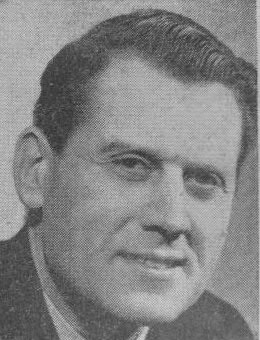
Douglas Lionel Hele was a pioneering British motorcycle engineer with Triumph and other firms: BSA, Douglas and Norton. He was born in Birmingham in 1919 and died in Hagley, Worcestershire on 2 November 2001.

The featherbed frame was a motorcycle frame invented by the McCandless brothers and offered to the British Norton motorcycle company to improve the performance of their racing motorcycles in 1950. It was considered revolutionary at the time, and the best handling frame that a racer could have. Later adopted for Norton production motorcycles, it was also widely used by builders of custom hybrids such as the Triton, becoming legendary and remaining influential to this day.
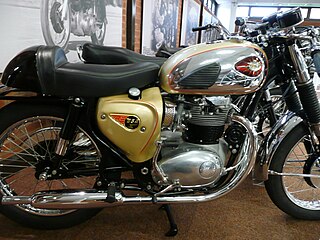
The BSA Lightning Clubman was a 650cc British motorcycle made by BSA at their factory in Birmingham between 1964 and 1965. Finished in gold and black the Lightning Clubman is now a highly sought after classic motorcycle. Due to the very limited production numbers replicas are created by enthusiasts from the BSA Lightning.

The Dunstall Norton was a Norton motorcycle made by Paul Dunstall, a specialist tuner of the 1960s and early 1970s twins originally using some parts from Norton's Domiracer project when the Birmingham factory was closed in 1963. In 1966 Dunstall Motorcycles became a motorcycle manufacturer in its own right so that Dunstalls could compete in production races, and set a number of world records before sales of the Dunstall Nortons declined in the 1970s consistent with the demise of the British motor cycle industry and a corresponding rise in Japanese imports.

Cheney Racing is a British motorcycle manufacturer, founded by Eric Cheney, based in Petersfield, Hampshire which builds complete specialist high performance motocross motorcycles, rolling chassis or frame kits to individual customer specifications.
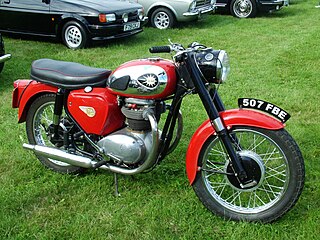
The BSA A65 Star was a Birmingham Small Arms Company (BSA) motorcycle aimed at the US market for unit construction twins. As well as giving a clean look to the engine, with the pushrod passages part of the cylinder block casting, unit construction reduced the number of places oil could leak from. A range of A65 Star twins was produced between 1962 and 1972.

Colin Jordan Seeley was a British motorcycle retailer who later became a motorcycle sidecar racer, motorcycle designer, constructor and retailer of accessories. In 1992 he was involved in running the Norton Rotary race team.

BSA motorcycles were made by the Birmingham Small Arms Company Limited (BSA), which was a major British industrial combine, a group of businesses manufacturing military and sporting firearms; bicycles; motorcycles; cars; buses and bodies; steel; iron castings; hand, power, and machine tools; coal cleaning and handling plants; sintered metals; and hard chrome process.
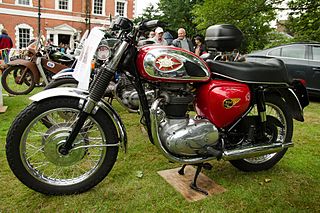
The BSA unit twins were a range of unit construction twin-cylinder motorcycles made by the Birmingham Small Arms Company (BSA) and aimed at the US market. A range of 500 cc (31 cu in), 650 cc (40 cu in) and 750 cc (46 cu in) twins were produced between 1962 and 1972, but they were really developments of the older pre-unit A7/A10 model range with less weight. The engines had a reputation for vibration, but acceleration was good for the time, to a top speed of 100 miles per hour (160 km/h).















